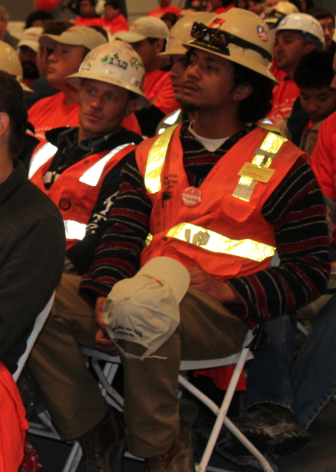Rail Yard Gets Green Light By L.A. Harbor Commission

The Los Angeles Harbor Commission voted unanimously on Thursday to continue progress on a proposed rail yard that has been met with community criticism despite claims it will create jobs and improve air quality.
A six-hour long hearing preceded the commission’s decision, which was attended by roughly 600 residents, union workers, environmental activists and city officials. Of those, about 200 publicly expressed their favor or opposition to the commission about the Southern California International Gateway rail yard– a $500 million project that will move its cargo-unloading facility within four miles of the port, as opposed to its current location 24 miles north.
The commission deliberated over the environmental impact of the project, re-assessing the residents’ concerns. But the decision was ultimately determined by jobs the project would provide as well as the opportunity to integrate cleaner, greener technology.
“All we want to do is live better and build cooperation… and what the project is about, in my opinion, is that the good jobs remain and grow,” said L.A. Harbor Commission Vice President David Arian. “The commissioners have proven themselves to work for cleaner air in the past. Those who oppose this should be with us and not be against.”
SEE ALSO: Union Strike Shuts Down Ports Of Los Angeles And Long Beach
The Southern California International Gateway facility, which is a project funded by BNSF Railway Co., has been in the proposal process since 2005. If approved by the L.A. City Council, the project is expected to be completed in 2016.
According to BNSF, relocating the rail yard closer to the Port of Los Angeles– where it would replace 150 industrial acres in Wilmington– is expected to create 22,000 jobs. Its closer proximity to the port would also keep 1.5 million trucks from having to use the I-710 Freeway.
BNSF plans to designate $100 million toward integrating more environmentally friendly technology, such as all-electric cranes and ultra-low emission locomotives, which would make it the greenest intermodal facility in the country, said Lena Kent, BNSF regional director of public affairs.
“Obviously truck traffic and emissions have been a source of contention in the local community and rightly so because they have felt that by living down in this area,” said Kent. “We really tried to hear what people’s concerns were and address those… so we literally went out, searched the world and found a manufacturer who could help us develop greener technology.”
The project would also help the ports of Los Angeles and Long Beach compete with the expansion of the Panama Canal, which could cause Asian cargo heading for the East Coast to bypass Los Angeles when it opens in 2015.
The creation of more jobs has been a strong selling point for the project not just for the commission but also for labor unions.
SEE ALSO: Southern California Economy Seems Slow And Steady
Nick Machado and Nate Crawford, two U.S. veterans, especially welcomed news that the project would move forward. They are about to enter the “Helmets to Hardhats” program that will train them for a career in construction.
While Machado and Crawford both live in the veteran’s village of Long Beach– part of the area that community members believe would be negatively impacted by the rail yard– they both see the project as a positive.
“When these jobs go through, we’re the ones who will fill the slots because we’ve got priority hiring to keep us working,” said Machado, 31, who served in Iraq with the Marine Corps. “I need that. I’ve got two kids and one on the way.”
Other residents and advocacy groups don’t feel the same. Citing personal issues with asthma, they worry that their health–and their children’s health–would be further compromised.
“Approval of the EIR means that local communities will have to continue to fight for their right to clean air," said Patricia Ochoa of Coalition for Clean Air. "No matter what window dressing you use to sell this project— children, families and jobs will be impacted.” *

Andrea Hricko, a professor of preventative medicine at the University of Southern California, is also concerned that the final environmental impact report didn’t include research by USC and UCLA, which studied children in Long Beach and found those who live or go to school near traffic pollution are more likely to develop lung problems and asthma.
"I want to make sure all of the science gets reflected in the report," Hricko said. “If this project goes through, there will be children playing at schoolyards several hundred feet from the rail yard."
SEE ALSO: The Accidental Activist: One Man's Quest For Environmental Justice
Felton Williams of the Long Beach Unified School District Board echoed this concern. So did Long Beach Mayor Bob Foster.
“When we look at the impacts, we see the tragedy of this project,” said Foster. “The costs will be borne by families and communities… sick kids, unemployed parents and more cancer.” His comments were met by thunderous applause from environmental activists.
Despite the commission voting to recommend the project to the L.A. City Council, there is a 30-day window for opposing groups to file an appeal, which David Pettit– a senior attorney with the Natural Resources Defense Council representing the residents– says he plans to do.
Angelo Logan, the director of East Yard Communities for Environmental Justice, said he and his organization would also refuse to be defeated by the commission’s vote and plan to issue a statement on Monday regarding how they will proceed.
“It’s not over. And we’re not treading lightly into our next steps,” said Logan.
* This piece has been updated from its original post.
Find more Neon Tommy coverage on the Port of Los Angeles here.
Reach Managing Editor Paige Brettingen here. Follow her here.



